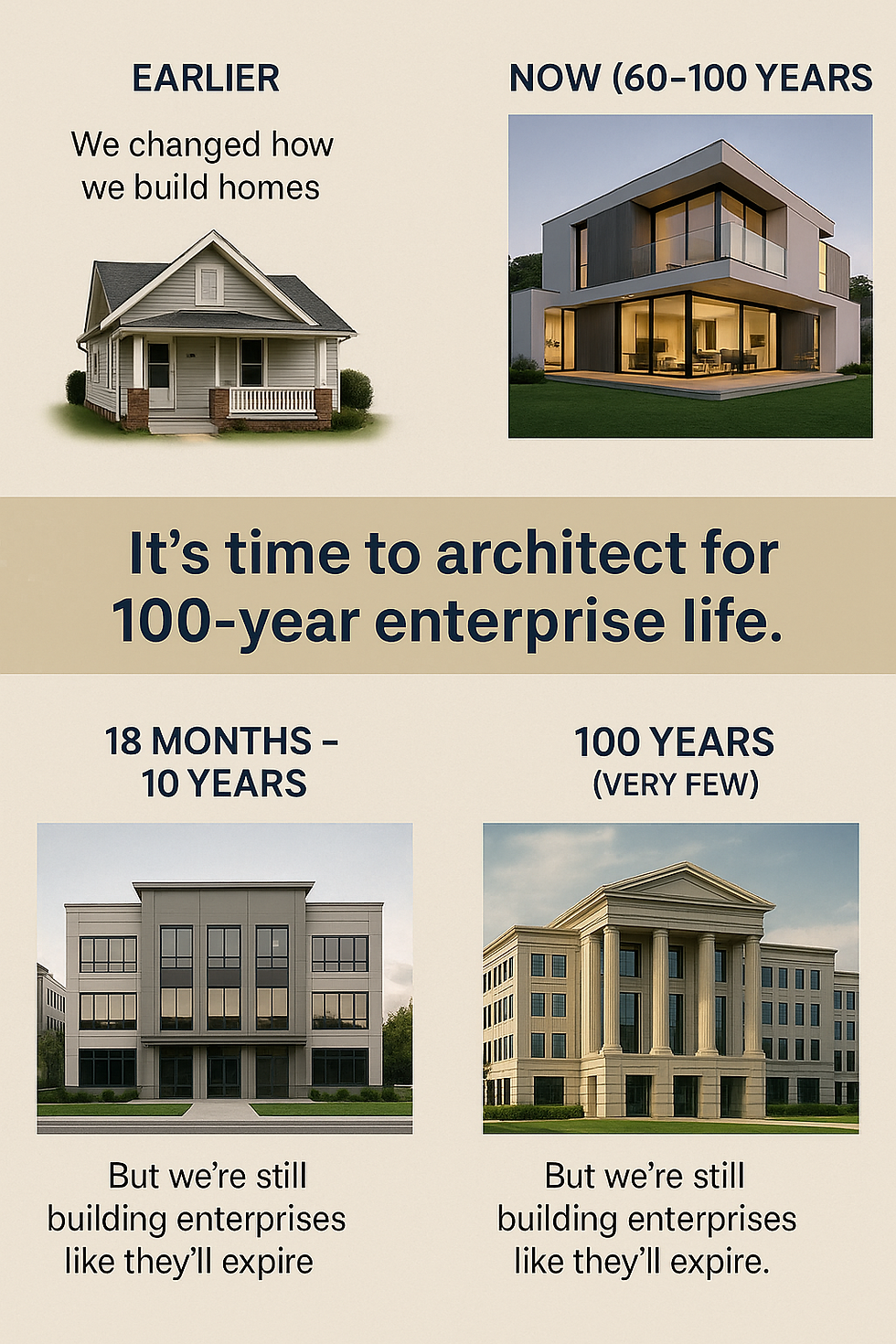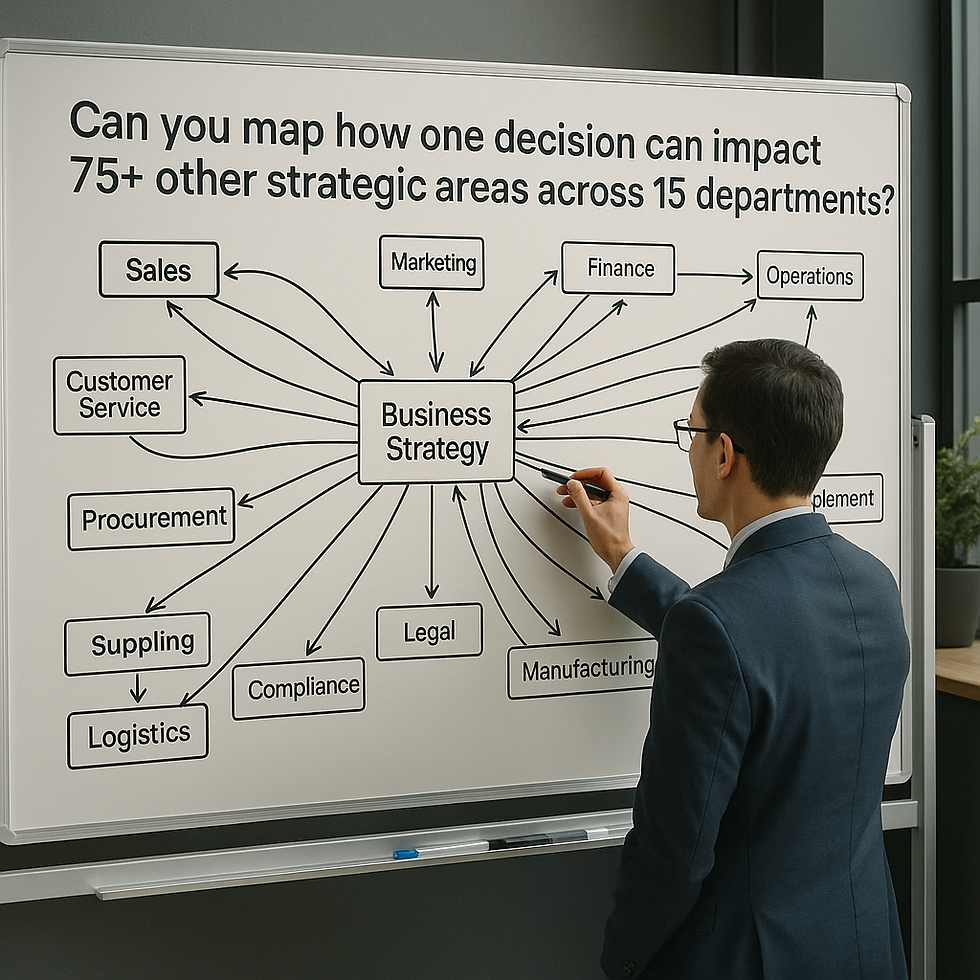The Architect CEOs - When Enterprise Must Survive 100 Years & Beyond
- Sunil Dutt Jha

- May 3
- 4 min read
Updated: May 17
Because survival isn’t about celebrating the past—it’s about architecting the next 100 years with structural intelligence.
In 1926, McKinsey & Company was founded by James McKinsey, a professor of accounting at the University of Chicago, with a singular focus on accounting. At the time, accounting wasn’t just a department; it was the entire enterprise. Everything revolved around financial management.
Organizations were structured around this singular function, and accounting governed nearly every aspect of the enterprise. The concept of separate departments like marketing, HR, or IT had yet to emerge, as accounting was considered the enterprise’s strategic backbone.
Fast forward to today, and accounting is one of many specialized departments, each playing a vital but distinct role in an enterprise’s success. Over time, other functions like marketing and HR, which were once part of sales and finance respectively, have also evolved into independent departments, reflecting their growing strategic importance.
Most Enterprises Are Built to Survive Trends—Not Time
Today, many CEOs wear the “100 years in business” label like a badge of honor. But longevity is not just about how long you’ve existed—it’s about how intelligently you’ve evolved.
Kodak. Nokia. Blockbuster.
All once dominant. All now case studies in strategic failure.

Why?
Not because they lacked technology—but because they lacked structural adaptability.
Why Longevity Now Requires a New Kind of Architect
AI. Quantum. Platforms. These technologies promise transformation—but also amplify volatility.
The enterprises that survive won't be the ones chasing tools. They’ll be the ones that understand their own anatomy—their internal logic, execution dependencies, and systemic design.
Longevity isn’t trend adoption. It’s structural alignment.
Who Is the Longevity Architect?
Not a systems integrator.
Not a framework decorator.
Not a vendor-agnostic orchestrator.
An Enterprise Longevity Architect is someone who:
Understands that departments are not silos—they are organs in a larger living system.
Can link strategy with the 450+ processes that actually execute it.
Sees how one decision can impact 75+ other strategic areas across 15 departments.
Thinks in decades, not quarters.
Why This Role Has Been Missing
Traditional leadership relies on org charts, capability models, and quarterly performance decks. But static views don’t account for the hidden interdependencies—the cross-functional logic, feedback loops, and timing patterns that define whether enterprises scale or stall.

What’s missing?
A new breed of architect who thinks structurally, acts strategically, and builds for time.
Enterprise Architecture today is mostly project-based, IT-centric, or reduced to tool alignment.
How ESAR-AG Enables This Role
The ICMG Strategy & Architecture Advisory Group (ESAR-AG) is not another “future of work” panel. It’s a working group for those shaping anatomy-based enterprise models that last.

Here, members don’t just discuss innovation. They evaluate integration, resilience, execution clarity, and long-term continuity.
They diagnose where 15 departments are misaligned, how strategies collapse in delivery, and why departments fail to function as one enterprise body.
This isn’t thought leadership. It’s structural leadership.
A Historical Perspective: John Zachman and the Roots of Enterprise Architecture
The concept of Enterprise Architecture has been shaped by decades of thought leadership, starting with John Zachman, who introduced the groundbreaking Zachman Framework in 1987 and is widely regarded as the founder of Enterprise Architecture. Zachman’s groundbreaking work emphasized that EA should be the architecture of the entire enterprise, not just IT. He envisioned the idea of Enterprise Engineering, where the architect acts as a strategic enabler for the whole organization.
Unfortunately, as IT complexities grew, the role of EA was often confined to managing IT challenges. While IT-focused EA has delivered significant value, it has overlooked the rising complexity of business operations, which continue to face growing challenges. True enterprise architects must now evolve into enterprise doctors, diagnosing and resolving cross-departmental complexities to ensure cohesive business strategy execution.
One Enterprise, One Anatomy: A Transformative Breakthrough
The biggest shift in enterprise architecture and engineering has been the development of the "One Enterprise, One Anatomy" framework. This breakthrough builds on the wisdom of over 1,000 thought leaders, from Peter Drucker to John Zachman, culminating in the revolutionary ICMG Anatomy Model.

This model integrates the strategies, processes, systems, components, and operations of all 15 departments into a unified framework, enabling true enterprise-wide alignment. It goes beyond traditional models by addressing:
Cross-departmental strategy execution: Ensuring every decision aligns with the organization’s overarching goals.
Breaking silos: Unifying processes and operations across all functions.
Enterprise adaptability: Providing a robust foundation for navigating complexity and change.
Why "One Enterprise, One Anatomy" is a Breakthrough
Like medical anatomy revolutionized healthcare by providing a clear understanding of the human body’s systems and functions, enabling longevity and short-term efficiency, "One Enterprise, One Anatomy" does the same for enterprises. It brings: -Long-term enterprise resilience: Aligning strategy execution with sustainable growth. - Short-term effective strategy execution and efficiency: Ensuring cohesive operations and immediate performance gains.
Transforming 100 years of enterprise evolution: By weaving together lessons from thought leaders and modern business needs, it reshapes how enterprises operate and thrive in complex environments.
The New Architect’s Mindset
A Longevity Architect:
Plans for multi-decade evolution
Sees enterprise execution like a doctor sees organ systems
Thinks across data, rules, process, timing, and structure—not just tools
Looks for the anatomy, not just the appearance
They don’t just respond to disruption—they build systems that absorb it.
If You’ve Been Working Like This Already...
-If you’ve spent your career uncovering inefficiencies others ignore...
-If you’ve designed cross-department logic most leaders don’t understand...
-If you’ve always seen strategy as a structural execution problem...
You’re already a Longevity Architect.
Now it’s time to formalize it.
To join others who think like you. And to define how the next century of enterprises are designed, evaluated, and sustained.
Join ESAR-AG. Not to be labeled a visionary—But to finally be the architect of enterprise longevity.

